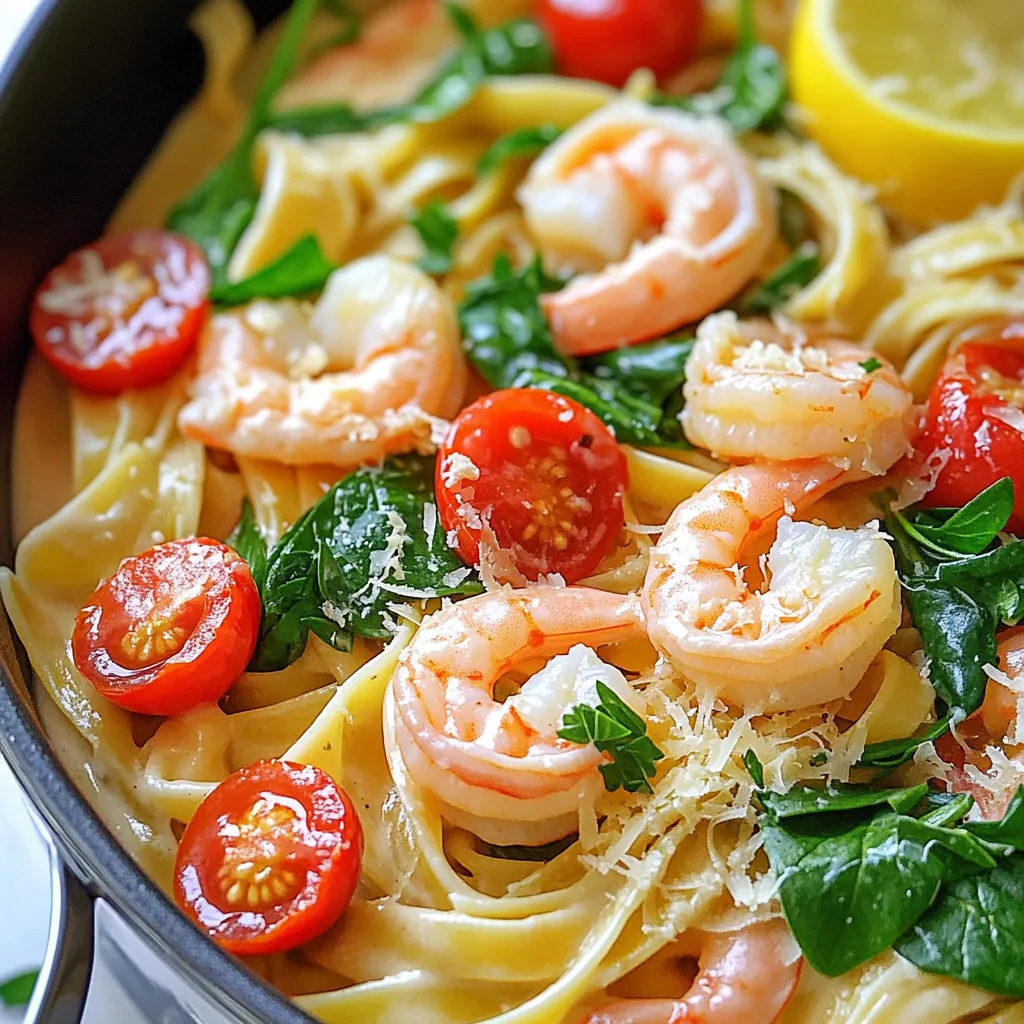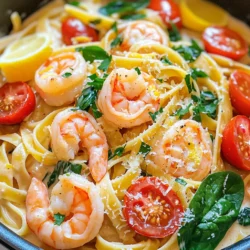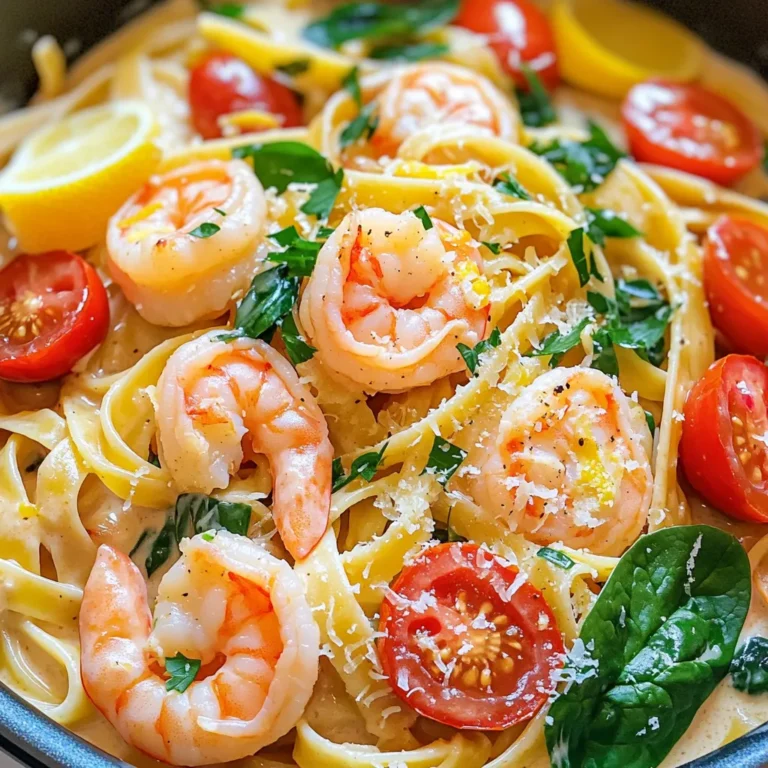Get ready to impress with a dish that’s as easy as it is delicious! In this blog post, I will guide you through making One-Pot Creamy Lemon Garlic Shrimp Pasta. With just a handful of ingredients, this dish explodes with flavor. You’ll learn about ingredient swaps, cooking tips, and storage secrets. Say goodbye to boring dinners and hello to culinary delight that will leave everyone wanting more! Let’s dive in!
Ingredients
Complete ingredient list for One-Pot Creamy Lemon Garlic Shrimp Pasta
To make this tasty dish, gather these ingredients:
– 12 oz. linguine or spaghetti
– 1 lb. large shrimp, peeled and deveined
– 4 cloves garlic, finely minced
– 2 tablespoons extra virgin olive oil
– 1 cup heavy cream
– 1 cup low-sodium chicken broth
– Zest and juice of 1 lemon
– 1 cup cherry tomatoes, halved
– 1 cup fresh spinach leaves
– 1/2 cup grated Parmesan cheese
– Salt and freshly ground black pepper to taste
– Fresh parsley, chopped (for garnish)
Ingredient substitutions for dietary preferences
You can swap ingredients to fit diets. Here are some ideas:
– Use whole wheat pasta instead of regular pasta for more fiber.
– Swap shrimp for chicken or tofu for a different protein.
– Use vegetable broth instead of chicken broth for a vegetarian option.
– Replace heavy cream with coconut milk for a dairy-free version.
– Try nutritional yeast instead of Parmesan for a vegan twist.
Fresh vs. frozen shrimp: Which is better?
Fresh shrimp taste great, but frozen shrimp are often just as good. They are usually frozen right after catch. This keeps their flavor and texture. When using frozen shrimp, thaw them overnight in the fridge or under cold water. Fresh shrimp can be more expensive, but they have a nice snap and flavor. Both options can work well in your creamy lemon garlic shrimp pasta.
Step-by-Step Instructions
Detailed cooking procedure for perfect pasta
To start, heat 2 tablespoons of extra virgin olive oil in a large pot. Use medium heat. Once hot, add 4 cloves of minced garlic. Sauté for about 1 minute until it smells great. Be careful not to burn the garlic. This step adds a lot of flavor to your dish.
Next, add 1 pound of peeled and deveined shrimp. Season with salt and freshly ground black pepper. Cook for 2-3 minutes. The shrimp will turn pink when done. Once cooked, take the shrimp out and set them aside.
In the same pot, pour in 1 cup of low-sodium chicken broth. Add 1 cup of heavy cream, the zest, and juice of 1 lemon. Stir well and bring it to a gentle simmer. This creates a rich sauce.
Add 12 ounces of linguine or spaghetti directly into the simmering sauce. Check the package for cooking time, usually 9-11 minutes. Stir occasionally to keep the pasta from sticking. Cook until the pasta is al dente.
Once your pasta is cooked, fold in 1 cup of halved cherry tomatoes, 1 cup of fresh spinach, and the cooked shrimp. Mix it all together. The spinach will wilt in just 1-2 minutes. This step adds color and nutrition.
Taste your dish and adjust seasoning. You might want more salt, pepper, or lemon juice for extra flavor. Serve your creamy lemon garlic shrimp pasta hot. Garnish with freshly chopped parsley for a beautiful finish.
Tips for ensuring shrimp is cooked perfectly every time
To cook shrimp perfectly, be mindful of their color. They should look pink and opaque. Avoid overcooking them, as they can become rubbery. Cooking for 2-3 minutes should be enough. Always remove them from the heat when they are just done. This keeps them tender and juicy.
How to achieve a creamy sauce consistency
For a creamy sauce, the right ratio of chicken broth to cream is key. Use 1 cup of each. This balance helps create a rich texture. Stir well as the sauce simmers. The heat helps the sauce thicken. If it’s too thick, add a splash of chicken broth. If it’s too thin, let it simmer a bit longer. The goal is a smooth, luscious sauce that clings to the pasta perfectly.
Tips & Tricks
Essential kitchen tools for making this recipe
To make this creamy lemon garlic shrimp pasta, you need some key tools:
– Large pot or deep skillet
– Cutting board
– Sharp knife
– Measuring cups and spoons
– Wooden spoon or spatula
– Serving plates
These tools will help you cook efficiently and serve the dish nicely.
Common mistakes to avoid when cooking shrimp pasta
When cooking shrimp pasta, watch out for these common mistakes:
– Overcooking shrimp: Cook shrimp for just 2-3 minutes until pink.
– Burning garlic: Sauté garlic for only 1 minute to avoid bitterness.
– Not salting the pasta water: This adds flavor to the pasta.
– Adding shrimp too early: Cook shrimp last to keep them tender.
Avoiding these mistakes will help you create a perfect dish every time.
Flavor enhancements: herbs and spices to consider
To add more flavor to your pasta, consider these herbs and spices:
– Fresh basil: Adds a sweet aroma.
– Red pepper flakes: Gives a nice heat.
– Dried oregano: Adds depth and earthiness.
– Fresh thyme: Offers a subtle, herbal note.
Feel free to experiment with these to make your dish unique!

Variations
Vegetarian and vegan adaptations
If you want a meat-free meal, switch the shrimp for firm tofu or chickpeas. Both add protein and texture. Use coconut cream or a vegan cream substitute for the sauce. You can still enjoy the lemon and garlic flavors. Just remember to sauté the garlic in olive oil before adding it to the cream.
Different pasta types that work well with this recipe
While linguine or spaghetti are great, other pasta types work too. Fusilli, penne, or even gluten-free pasta can all shine in this dish. Choose what you like best or what you have on hand. The key is to cook it until it’s al dente. This way, it will soak up the creamy sauce perfectly.
Adding vegetables for extra nutrition
Boost the health of your meal by adding more veggies. Spinach is great, but you can also add zucchini, bell peppers, or broccoli. Just chop them small and toss them in with the pasta. This increases the vitamins and makes the dish even more colorful. You can enjoy a tasty meal while being healthy too!
Storage Info
How to store leftovers properly
To keep your One-Pot Creamy Lemon Garlic Shrimp Pasta fresh, store it in an airtight container. Make sure it cools down to room temperature first. Then, place it in the fridge. It’s best to eat leftovers within three days. If you wait too long, flavors may change.
Reheating tips to maintain texture and flavor
When you’re ready to reheat, use the stove for the best results. Heat in a pan over medium-low heat. Add a splash of chicken broth or a bit of cream to keep it creamy. Stir often to avoid burning. If you use a microwave, cover the bowl to keep moisture in. Heat in short bursts, stirring in between.
Freezing the dish: What you need to know
You can freeze this pasta, but it’s best to do so without the shrimp. Cooked shrimp can turn rubbery when frozen. Cool the pasta and sauce completely, then place in a freezer-safe container. It should last up to three months. When ready to eat, thaw in the fridge, then reheat on the stove.
FAQs
Can I make this recipe ahead of time?
Yes, you can make this recipe ahead of time. Cook the pasta and shrimp. Then, mix them with the sauce just before serving. This keeps the pasta fresh and tasty. Store everything in the fridge for up to two days. Reheat gently in a pan on low heat. This helps avoid overcooking the pasta and shrimp.
How do I fix overcooked pasta?
If your pasta is overcooked, you can try a few tricks. First, drain the pasta and rinse it under cold water. This stops the cooking process. Next, quickly reheat it in a pan with a bit of olive oil. This can help revive its texture. Adding sauce can also help hide the softness.
Can I use a different type of cream for this recipe?
Yes, you can use different types of cream. Half-and-half works well for a lighter option. You can also try coconut cream for a dairy-free choice. Keep in mind that the flavor and texture may change slightly. Adjust the amount to get the creaminess you want.
This blog post covered how to make One-Pot Creamy Lemon Garlic Shrimp Pasta. We explored important ingredients, cooking steps, and tips for success. You learned about shrimp choices, substitutions, and variations to fit your needs.
Remember, the right tools and methods make a big difference. Try adding more veggies or changing the pasta. With practice, you can create a dish that impresses and warms anyone’s heart. Enjoy your cooking journey!


